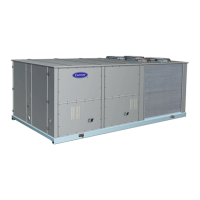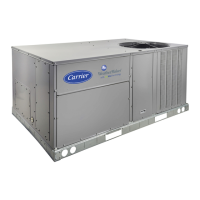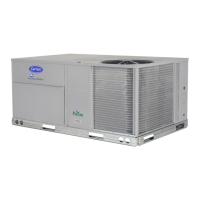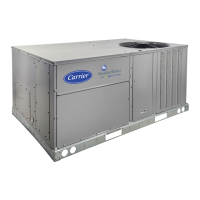9
Coil Maintenance and Cleaning Recommendation
Routine cleaning of coil surfaces is essential to maintain proper
operation of the unit. Elimination of contamination and removal of
harmful residues will greatly increase the life of the coil and ex-
tend the life of the unit. The following maintenance and cleaning
procedures are recommended as part of the routine maintenance
activities to extend the life of the coil.
Removing Surface Loaded Fibers
Surface loaded fibers or dirt should be removed with a vacuum
cleaner. If a vacuum cleaner is not available, a soft non-metallic
bristle brush can be used. In either case, the tool should be applied
in the direction of the fins. Coil surfaces can be easily damaged.
Applying the tool across the fin edges can cause the edges to be
easily bent over, damaging the coating of a protected coil.
NOTE: Use of a water stream, such as a garden hose, against a
surface-loaded coil will drive the fibers and dirt into the coil. This
will make cleaning efforts more difficult. Surface-loaded fibers
must be completely removed prior to using a low-velocity clean
water rinse. A vacuum cleaner or a soft-bristled brush should be
used to remove surface-loaded fibers and dirt.
Periodic Clean Water Rinse
A periodic clean-water rinse is very beneficial for coils that are
used in coastal or industrial environments. However, it is very im-
portant that the water rinse is made with a very low-velocity water
stream to avoid damage to the fin edges. Monthly cleaning, as de-
scribed below, is recommended.
Routine Cleaning of Evaporator Coil Surfaces
Monthly cleaning with Totaline environmentally sound coil clean-
er is essential to extend the life of the coils. This cleaner is avail-
able from Carrier Replacement Parts Division (P/N: P902-0301
for a one gallon (3.8L) container, and P/N: P902-0305 for a
5 gallon (18.9L) container). It is recommended that all round tube
coils be cleaned as described below. Coil cleaning should be part
of the unit’s regularly scheduled maintenance procedures to ensure
a long life for the coil. Failure to clean the coils can result in re-
duced durability in the environment. When cleaning the coils,
avoid use of the following:
• coil brighteners
• acid cleaning prior to painting
• high pressure washers
• poor quality water for cleaning
Totaline environmentally sound coil cleaner is a nonflammable,
hypo allergenic, non bacterial, USDA accepted biodegradable
agent that will not harm the coil or surrounding components such
as electrical wiring, painted metal surfaces, or insulation. Use of
non-recommended coil cleaners is strongly discouraged since coil
and unit durability could be affected.
TOTALINE ENVIRONMENTALLY SOUND COIL
CLEANER APPLICATION EQUIPMENT
• 2
1
/
2
gallon garden sprayer
• Water rinse with low velocity spray nozzle
TOTALINE ENVIRONMENTALLY SOUND COIL
CLEANER APPLICATION INSTRUCTIONS
1. Proper protection such as safety glasses, gloves and pro-
tective clothing are recommended during mixing and
application.
2. Remove all surface loaded fibers and dirt with a vacuum
cleaner as described above.
3. Thoroughly wet finned surfaces with clean water and a low
velocity garden hose, being careful not to bend fins.
4. Mix Totaline environmentally sound coil cleaner in a
2
1
/
2
gallon (9.6 L) garden sprayer according to the instruc-
tions included with the cleaner. The optimum solution tem-
perature is 100°F (38°C).
NOTE: Do NOT USE water in excess of 130°F (54°C), as the en-
zymatic activity will be destroyed.
5. Thoroughly apply Totaline environmentally sound coil
cleaner solution to all coil surfaces, including finned area,
tube sheets and coil headers.
6. Hold the garden sprayer nozzle close to finned areas and
apply cleaner with a vertical, up-and-down motion.
7. Avoid spraying in a horizontal pattern to minimize potential
for fin damage.
8. Make sure the cleaner thoroughly penetrates deep into the
finned areas.
9. Interior and exterior finned areas must be thoroughly cleaned.
10. Finned surfaces should remain wet with cleaning solution for
10 minutes.
11. Make sure surfaces are not allowed to dry before rinsing.
Reapply cleaner as needed to ensure 10 minute saturation is
achieved.
12. Thoroughly rinse all surfaces with low-velocity clean water
using a downward rinsing motion of the spray nozzle. Protect
fins from damage from the spray nozzle.
Evaporator Coil Metering Devices
The metering devices are multiple fixed-bore devices (Acutrol)
swedged into the horizontal outlet tubes from the liquid header, lo-
cated at the entrance to each evaporator coil circuit path. These are
non-adjustable. Service requires replacing the entire liquid header
assembly.
To check for possible blockage of one or more of these metering
devices, disconnect the supply fan contactor (IFC) coil, then start
the compressor and observe the frosting pattern on the face of the
evaporator coil. A frost pattern should develop uniformly across
the face of the coil starting at each horizontal header tube. Failure
to develop frost at an outlet tube can indicate a plugged or a miss-
ing orifice.
CAUTION
UNIT DAMAGE HAZARD
Failure to follow this caution may result in accelerated corro-
sion of unit parts.
Harsh chemicals, household bleach or acid or basic cleaners
should not be used to clean outdoor or indoor coils of any kind.
These cleaners can be very difficult to rinse out of the coil and
can accelerate corrosion at the fin/tube interface where dissim-
ilar materials are in contact. If there is dirt below the surface of
the coil, use the environmentally balanced coil cleaner.
CAUTION
PERSONAL INJURY HAZARD
Failure to follow this caution can result in severe personal inju-
ry and reduced unit performance.
High velocity water from a pressure washer, garden hose, or
compressed air should never be used to clean a coil. The force
of the water or air jet will bend the fin edges and increase air-
side pressure drop.
High velocity water from a pressure washer can cause severe
injury upon contact with exposed bodily tissue. Always direct
the water stream away from the body.

